Nyborg
Nyborg is a city in central Denmark, located in Nyborg Municipality on the island of Funen and with a population of 17,268 (2020). It is the easternmost settlement on Funen. By road, it is located 34 km east of Odense, 35 km north of Svendborg and 21 km south of Kerteminde. It also connects to Korsør through the Great Belt Bridge. Nyborg is the seat of Nyborg Municipality, and until 1793 it was also the seat of Nyborg County.
Nyborg | |
|---|---|
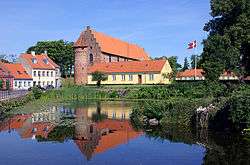 Nyborg Castle | |
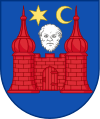 Coat of arms | |
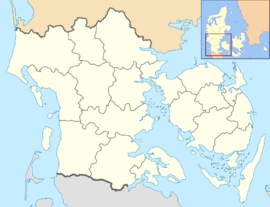 Nyborg Location in the Region of Southern Denmark | |
| Coordinates: 55°18′N 10°47′E | |
| Country | |
| Region | |
| Municipality | |
| Founded | Early 1200s |
| Area | |
| • Urban | 11.2 km2 (4.3 sq mi) |
| Population (2020)[1] | |
| • Urban | 17,268 |
| • Urban density | 1,500/km2 (4,000/sq mi) |
| Postal code | 5800 |
| Website | Nyborg.dk |
The city was founded in the 1200s, built up around Nyborg Castle. The castle holds a central place in Nyborg geographically, historically and culturally.
Etymology
Nyborg was first mentioned in 1193 as 'Nyburg', which translates to 'new castle' in Danish.[2]
History
Before Nyborg was founded, a fortification existed in the area under the name of Gammelborg. It was established in the 500s, and used throughout the Viking age until Nyborg was founded and took over its role.[3]
Nyborg was first mentioned in 1193 in the history of Denmark as Nyborg Castle, which still exists today, but the town itself was not mentioned before the year 1202. From its foundation and until 1413, Nyborg Castle was used by numerous kings as seat of the Danehof and other meetings. The first Constitution of Denmark was written on Nyborg Castle by Eric V in 1282. Being the seat of these meetings, Nyborg enjoyed a number of unique and special privileges, granted by the king. The first was granted by king Valdemar II, who granted the town the status of a market town (Danish: Købstad) shortly after the town was founded. Merchants from neighboring hundreds had to come to Nyborg to sell their wares, boosting the economy and traffic in the town. In 1446, a large number of additional privileges were added, including the outlawing of harbours between the market towns on eastern Funen. Nyborg was also given permission to host a yearly market, and artisans from Vindinge Hundred were told to move to the market towns, boosting the population and economy of Nyborg once more. With the king visiting regularly, due to Nyborg's central location and the castle being the seat of the Danehof, Nyborg was given many additional privileges over the years.[4]
In 1525 Frederick I declared Nyborg as the king's residency, and until the 1560s it acted as the capital of Denmark. During this time, Christian III expanded Nyborg Castle and city. Much of the castle was rebuild and a tournament ground was built in front of the castle.[5]
The city was captured by Swedish troops during the Dano-Swedish War, following the Battle of Nyborg. The Swedish troops sent all valuables home to Sweden and ruined much of Nyborg Castle. Following this, the king was no longer interested in living in the castle, and it was handed over to the military. Nyborg worked as a garrison, with the castle now being used for military purposes.[6]
After the wars and several fires and livestock plagues, the 1700s were a low period in Nyborg's history, with the population growing poorer. Things turned around in the 1800s where Nyborg became and important link across the Great Belt, with steamboat ferries starting to sail between Nyborg and Korsør in 1828. Several large markets were also held yearly, and the trade and economy of the town began to grow again.[7]
In the Second World War, Nyborg's garrison still existed. Denmark was allowed to keep their military after the Nazi occupation. Nyborg Vandrehjem and Hotel Nyborg Strand housed Danish soldiers. On 29 August 1943 Operation Safari was carried out, with the intention of disarming the Danish military. Battles occurred between the Danish and German soldiers on both Nyborg Vandrehjem and Hotel Nyborg Strand. Two Danish soldiers were killed at Hotel Nyborg Strand: Cornet K.B. Madsen and Captain C.L. Wesenberg. The captain was killed by a German soldier, who also killed himself at the same time by accidentally blowing up them both with a grenade. That German soldier was most likely the only German casualty of the battle.[8] There was a single Danish casualty during the battle at Nyborg Vandrehjem: Recruit Ivan Jacobsen.[9]
In 1977 market towns were dissolved, and Nyborg lost its title. Nyborg Municipality was established, with Nyborg being the seat of the new municipality. It was formed of the city and parish of Nyborg, as well as the two parish municipalities of Avnslev-Bovense and Vindinge. In the 2007 municipal reform, the three municipalities of Nyborg, Ørbæk and Ullerslev were merged to form the present Nyborg Municipality.
Historical populations
|
| ||||||||||||||||||||||||||||||||||||||||||||||||||||||||||||||||||||||||||||||||||||||||||
| Source: Bolius.dk, Byhistorie.dk | |||||||||||||||||||||||||||||||||||||||||||||||||||||||||||||||||||||||||||||||||||||||||||
Nyborg Castle
Nyborg Castle is located near the center of Nyborg city, and is surrounded by fortifications, the 'castle lake' and a moat that run along the center of the city. The castle if first mentioned in 1193, when Canute VI held a meeting in it. Before then, the king were housed in Hjulby, outside Nyborg, and the castle was established in that period. A curtain wall was built, and there has likely been several wooden buildings within the walls. In the first half of the 1200s, a building was constructed in two floors, much of which still remain today. The king likely held his meetings in the upper floor of this construction. During the 1300s and 1400s, the castle was improve upon, with a new floor and several new buildings. In 1282, Eric V completed the constitution of Denmark in Nyborg Castle. In 1287, Eric V's alleged murderers were sentenced on the castle. In the 1520s, Frederick I planned to make Nyborg his official residence, but that never happened. Signs of his plans were obvious, however, with major projects on the castle planned.[10]
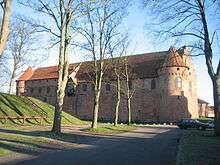
After the Dano-Swedish War, where the castle was captured and later turned into armory, the importance of the castle fell. The garrison was disestablished in 1913. The castle was turned into a museum, which it has been since then. In 2017, a large project to renovate and expand the museum was begun, with plans to finish in 2023.[11]
The fortifications, ramparts and moats surrounding Nyborg Castle stretch out along the center of the city. The moats appear as they did in the Middle Ages, with the same water regulation systems still in use. Three of the original bulwarks still exist, with the remaining having been torn down during city expansions. Two of those bulwarks are located around Nyborg Castle, and are known as the Queen's Bulwark (Danish: Dronningens Bastion) and the Crown Prince's Bulwark (Danish: Kronprinsens Bastion). Those are surrounded by the original ramparts, which today act as park areas. On the Queen's Bulwark is a water tower from 1899, built by Emil Swanenflügel. The water tower was protected in 1997. The third bulwark is called Prince Carl's Bulwark (Danish: Prins Carls Bastion), and is slightly smaller. It also acts as a park area.[12][13]
Nyborg Church
Nyborg Church (also known as Church of Our Lady. Danish: Vor Frue Kirke) is located in the center of Nyborg, and was built in 1375–1428. It was renovated in the 1970s and again in 2005.
The church has two organs, from 1973 by Poul-Gerhard Andersen and 1830 by P.U.F. Demant. The crucifix is the only piece of inventory from the church's opening in 1428. It is decorated with biblical depictions. Maja Lisa Engelhardt created the altar crucifix, of gilded bronze, in 2011. Maja Lisa Engelhardt also created a mosaic for the church in 2015. The largest of the church's chandeliers was donated in 1640 by the mayor's widow, Sidsel Knudsdatter. The other chandelier was donated by mayor Mads Lerke in 1589. The renaissance baptismal font was donated to the church in 1585 by mayor Peder Jensen Skriver. The other baptismal font is Romanesque style in granite, from 1100. Inside the church is a gate from 1649, built by Christian IV's smith, Caspar Fincke. The pulpit is from 1653, made by Anders Mortensen in Odense. The pulpit's staircase is even older. The church has a set of wooden figures of John the Apostle and Jeremiah. Like the pulpit, they were also carved by Anders Mortensen. A candle globe, made by local artisan Flemming Knudsen, was added to the church in 2008.[14][15]
The church's turret clock, nicknamed "the Syrian tank" (Danish: Den syriske kampvogn) was replaced by an electric movement in 1972. The original mechanical movement was built by Henrik Kyhl from Copenhagen, and initially created for Viborg Cathedral, who couldn't afford it. It was instead bought by Nyborg Church. In 2002 it was donated to Post- og Telemuseet in Copenhagen.[16]
Notable people
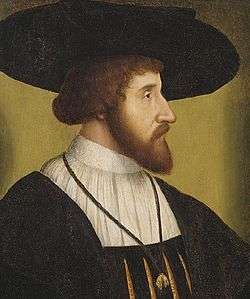
Nobility & Public thinking
- Christian II of Denmark (1481 in Nyborg Castle – 1559) King of Denmark and Norway 1513-1523 and Sweden 1520-1521
- Christina of Denmark (1521 in Nyborg – 1590) a princess, daughter of Christian II of Denmark
- Adam Abraham von Gaffron und Oberstradam (1665–1738) of the Gaffron family, died and buried in Nyborg
- Karl Johann von Königsmarck (1659 in Nyborg – 1686) a Swedish count and soldier
- Johan Theodor Holmskiold (1731 in Nyborg – 1793) a Danish noble, botanist and courtier
- Ole Berendt Suhr (1813 in Nyborg – 1875) a Danish merchant and landowner
- Johannes Theodor Suhr (1896 in Nyborg – 1997) a Danish Roman Catholic bishop
- Bodil Begtrup (1903 in Nyborg - 1987) a Danish women's rights activist and diplomat
The Arts
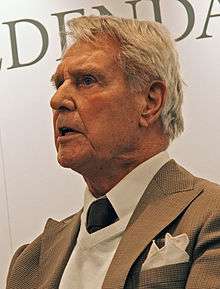
- Carl Aarsleff (1852 in Nyborg – 1918) a Danish sculptor
- Sextus Miskow (1857 in Nyborg – 1928) a Danish singer, composer and music critic
- Frederik Jensen (1863 in Nyborg – 1934) a Danish stage and film actor [17]
- Helge Kjærulff-Schmidt (1906 – in Nyborg 1982) a Danish stage and film actor [18]
- Erik Balling (1924 in Nyborg – 2005) a Danish TV and film director [19]
- Holger Juul Hansen (1924 in Nyborg – 2013) a Danish actor [20]
- Elsebeth Egholm (born 1960 in Nyborg) a Danish journalist and author of crime fiction novels
- Søren Huss (born 1975 in Nyborg) a Danish singer, songwriter and musician
Sport
- Ragnhild Hveger (1920 in Nyborg – 2011) a Danish swimmer, silver medallist at the 1936 Summer Olympics
- Søren Skov (born 1954 in Nyborg) a former professional footballer, over 250 club caps
- Dorte Jensen (born 1972 in Nyborg) a sailor, team silver medallist at the 2004 Summer Olympics
- Kathrine Heindahl (born 1992 in Nyborg) a handball player with 71 caps for Denmark
- Søren Toft Hansen (born 1992 in Nyborg) a Danish male badminton player
- Frederik Søgaard (born 1997 in Nyborg) a Danish badminton player
External links
References
- BY3: Population 1 January, by urban areas The Mobile Statbank from Statistics Denmark
- Denstoredanske.lex.dk "Nyborg" Retrieved 1 August 2020
- Historie-online.dk "Nyborg afløse Gammelborg" Retrieved 3 August 2020
- Ddb.byhistorie.dk "Nyborg" Retrieved 1 August 2020
- Visitnyborg.dk "Nyborgs historie" Retrieved 1 August 2020
- Nyborgslot.dk "Efter kongerne" Retrieved 18 April 2019
- Danmarkshistorien.dk "Nyborg" Retrieved 1 August 2020
- Larsen, John Maalø. "Oprør og Kamp i Nyborg 1943". Page 71.
- Larsen, John Maalø. "Oprør og Kamp i Nyborg 1943". Page 88.
- Nyborgslot.dk "Middelalderen" Retrieved 18 April 2019
- Nyborgslot.dk "Restaurering" Retrieved 18 April 2019
- Nyborgslot.dk "Nyborg Fæstning og Volde" Retrieved 21 April 2019
- Nyborgfaestning.dk "Vandtårnet" Retrieved 21 April 2019
- Nyborgkirke.dk "Vor Frue Kirke" Retrieved 20 April 2019
- Danmarks-kirker.dk "Vor Frue Kirke Nyborg" Retrieved 20 April 2019
- Fyens.dk "Tag bare det gamle kirkeur" Retrieved 20 April 2019
- IMDb Database retrieved 14 May 2020
- IMDb Database retrieved 14 May 2020
- IMDb Database retrieved 14 May 2020
- IMDb Database retrieved 14 May 2020